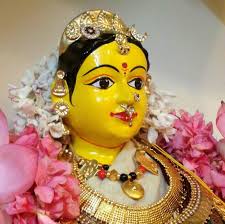
Gowri Devi Puja is a significant Hindu ritual dedicated to Goddess Gowri, an incarnation of Parvati, the divine consort of Lord Shiva. The puja is mainly performed by women, especially during the Gowri Habba (also known as Gowri Puja), which is celebrated a day before Ganesh Chaturthi in the Indian states of Karnataka, Andhra Pradesh, and Maharashtra. The ritual is dedicated to seeking the goddess’s blessings for marital bliss, prosperity, good health, and happiness.
The preparation for the puja begins with cleaning the home, especially the puja area. An idol or picture of Goddess Gowri, often depicted as a beautiful and serene deity, is placed on a clean pedestal or altar. The altar is decorated with flowers, mango leaves, and rangoli, symbolizing auspiciousness and divine presence.
Women performing the puja dress in new clothes, particularly in yellow, which symbolizes fertility and prosperity. The ritual starts by offering prayers to Lord Ganesha, seeking his blessings for the removal of obstacles. This is followed by Kalasha Sthapana, where a sacred pot filled with water, mango leaves, and a coconut is placed to invite divine energy.
Devotees offer a variety of fruits, sweets, and flowers to the goddess, especially banana, coconut, and turmeric, which are believed to be dear to her. Kumkum, rice, and vermilion are also offered during the ritual. Devotees chant Gowri Ashtakshara Mantra and sing Gowri Stotra to invoke the goddess’s blessings.
The puja concludes with an aarti, and the prasadam is distributed among family and friends. Gowri Puja is a celebration of femininity, strength, and prosperity, ensuring well-being, harmony, and abundance in the household.

